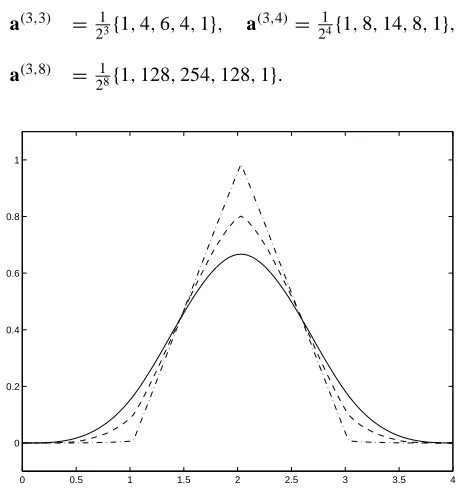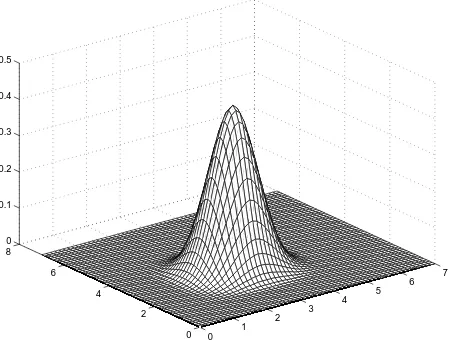Splines and Radial Functions
C. Conti - L. Gori - F. Pitolli
SOME RECENT RESULTS ON A NEW CLASS OF BIVARIATE
REFINABLE FUNCTIONS
Abstract. In this paper a new class of bivariate refinable functions is pre-sented and some of its properties are investigated. The new class is con-structed by convolving a tensor product refinable function of special type withχ[0,1], the characteristic function of the interval [0,1]. As in the case of box splines, the convolution product here used is the directional convo-lution product.
1. Introduction
It is well know that refinable functions play a key role in different fields like, just to mention two of the most significative, subdivision algorithms and wavelets. That is why there is an enormous amount of literature analyzing properties and applications of refinable functions in both the univariate and multivariate setting. In spite of their importance in many applications, the explicit form of refinable functions known in the literature reduces, in practice, to the two celebrated cases of B-splines and box-splines on uniform grids and of Daubechies refinable functions (see [2], [3], [6], and [7], for example). This is especially true in the multivariate setting where tensor product of univariate refinable functions are mainly taken into account. The considerations above motivated us in constructing and investigating a new family of bivariate non product refinable functions. Thus, starting with a bivariate function which is a tensor-product of finitely supported totally positive refinable functions, the new functions are obtained by using the directional convolution product with the characteristic function of the interval [0,1]. The idea is definitely borrowed from box-splines but the bivariate function we start with is not the characteristic function of [0,1]2. The univariate func-tions used to construct the tensor product belong to a large class of refinable funcfunc-tions introduced in [9], [8] by the two last authors so that they will be called GP functions. The class of GP functions contains as a particular case the cardinal B-splines with which they share many useful properties. The differences between the B-splines and the GP functions are mainly due to the fact that the refinement mask is characterized by one or more extra parameters that afford additional degrees of freedom which reveals its effectiveness in several applications.
The outline of the paper is as follows. In Section 2 we first recall the definition of the directional convolution product of a bivariate function and a univariate function. Then, we investigate which properties of the bivariate function are preserved after the
directional convolution withχ[0,1], the characteristic function of [0,1], is made. In Section 3 the new class of bivariate refinable functions is characterized. In the closing Section 4 a few examples are presented.
2. Directional convolution
We start this Section by recalling the definition of the directional convolution product (see also [7] for a possible use of it).
DEFINITION1. Let F :R2 → R, g : R→ Rbe a bivariate and a univariate
function, respectively, and let e∈Z2be a direction vector. Theconvolution product
between F and g along the direction e is defined as
(1) (F∗eg)(x):=
Z
R
F(x−et)g(t)dt, x∈R2.
Next, let8be a bivariaterefinable functionthat is a solution of arefinement equa-tionof type
(2) 8(x)= X
α∈Z2
aα8(2x−α), x∈R2,
where the set of coefficients aα forms the so calledrefinement maska = {aα, α ∈
Z2}. The mask a is supposed to be of compact support and satisfying
P
α∈Z2aα+2γ =1 for allγ ∈ {0,1}2. Furthermore, we assume that the Fourier trans-form of8satisfiesb8(0)=1. Here we define the Fourier transform of a given function
F as
(3) Fˆ(ω):=
Z
R2
F(x)e−iω·xd x.
Using the above introduced directional convolution product we defined the bivariate function9 :R2→R
(4) 9(x):=(8∗eχ[0,1])(x)=
Z 1
0
8(x−et)dt,
where e∈ {−1,0,1}2, andχ
[0,1], in the following for shortnessχ, is the characteristic function of the unit interval [0,1].
PROPOSITION1. Let8be a refinable function with refinement mask a such that P
b= {bα =
aα+aα−e
2 , α∈Z 2}.
Furthermore, the integer translates of9form a partition of unity, namelyPα∈Z29(·−
α)=1.
Proof. By the9definition we get
9(x) =R018(x−et)dt = X α∈Z2
aα
Z 1
0
8(2(x−et)−α)dt
= 12X α∈Z2
aα
Z 2
0
8(2x−et−α)dt
= 12X α∈Z2
aα
"Z 1
0
8(2x−et−α)dt+
Z 1
0
8(2x−et−α−e)dt #
= 12X α∈Z2
aα[9(2x−α)+9(2x−α−e)]
= X α∈Z2
1
2(aα+aα−e)9(2x−α)
so that9is refinable with refinement mask b= {bα= aα+aα−e
2 , α∈Z2}.
Next, since the Fourier transform of9is9(ω)b =8(ω)b χ (be·ω)for allω∈R2, from
b
8(0)=1 it trivially follows thatPα∈Z29(· −α)=9(b 0)=b8(0)=1 which is the
partition of unity for the function9.
A theorem is now dealing with the stability of9. We recall that the function9 is
L2-stable if there exist two constants 0<A≤B <∞such that
(5) 0<A||c||2≤ ||
X
α∈Z2
cα9(· −α)||2≤B||c||2
for any real sequence c= {cα, α∈Z2}inℓ2(Z2).
THEOREM 1. Let {8(· − α), α ∈ Z2} be linear independent and such that b
8(2πk) = δ0,k, whereδ0,k is the Kronecker symbol. Then, the integer translates of
9are linearly independent. Furthermore,{9(· −α), α ∈Z2}is a L
Proof. To prove the linear independence, it is sufficient to show that the set of the
complex periodic zeros of9bis empty, that is
ZC9= {θ∈C2|b9(θ+2πk)=0,∀k∈Z2} = {∅}
(see [12] for details). Now, since
b
9(θ+2πk)=8(θb +2πk)bχ(e·(θ+2πk)) ,
if θ is not a multiple of 2π, thenθ +2πk ∈/ 2πZ2 and8(θb +2πk) 6= 0, bχ (e·
(θ +2πk)) 6= 0,so that θ is not a periodic zero. If θ is a multiple of 2π, then
θ+2πk∈2πZ2and
b
8(θ+2πk)=
0, if k 6=K,
1, if k =K,
where K := −2θπ. Now, for k= K one hasbχ (e·(θ+2πK))=bχ (0)=1,so thatθ
is not a periodic zero. It follows the set Z9Cis empty.
We conclude with the observation that, obviously, also the set of the real periodic zeros of9bis empty, that is
Z9R= {θ∈R2|9(θb +2πk)=0,∀k∈Z2} = {∅},
which implies the L2-stable stability of the system of the integer translates of 9 as shown, again, in [12].
As a consequence of Theorem 1, the following corollary holds.
COROLLARY1. The refinable function9generates a multi-resolution analysis on L2(R2).
3. A new class of bivariate refinable functions
Aim of this Section is the construction of a specific class of refinable functions having all the properties of the9function discussed in the previous section. As8refinable function we consider a tensor product of particular univariate functions, that is (6) 8H1,H2(x):=ϕH1(x
1)ϕH2(x2) ,
where H1 =(n1,h1), H2=(n2,h2), and x =(x1,x2), and whereϕH1,ϕH2 are uni-variate functions belonging to the class of one parameter refinable functions introduced in [9]. We recall that the refinement mask of a GP function of typeϕH, H=(n,h), is supported on [0,n+1] and has positive entries
(7) aαH= 1 2h
n
+1
α
+4(2h−n−1)
n
−1
α−1
so that, whenever n=h, the functionϕHreduces to the B-splines of degree n. It is worthwhile to note that the real parameter h, h≥n ≥2, is an additional parameter which turns out to be useful for getting higher flexibility in the applications.
It is easy to see that the symbol associated with the refinement mask in (7) is
(8) pH(z)= 1
2h(1+z)
n−1(z2+(2h−n+2−2)z+1) .
For any n and h, (h ≥ n > 2), the function ϕH belongs to Cn−2(R), is centrally symmetric and the function system{ϕH(x−α), α∈Z}is linearly independent, stable
and satisfiesPα∈ZϕH(x−α) = 1 for all x ∈ R. Moreover, the Fourier transform
b
ϕH(ω)vanishes if and only ifω∈2πZ\ {0}.
With theϕHrefinable functions at hand we are able to construct a new class of bivariate refinable functions using the direction convolution product with direction e= (1,1). We define the function9H1,H2 as
(9)
9H1,H2(x) :=(8H1,H2 ∗
eχ )(x)
=R018H1,H2(x−et)dt=R1
0 ϕH1(x1−t)ϕH2(x2−t)dt. Note that the support of9H1,H2satisfies
supp(9H1,H2)⊂supp(8H1,H2)+[0,1]2,
where supp(8H1,H2)=[0,n
1+1]×[0,n2+1]. Moreover, the function9H1,H2 is such that
(10) 9bH1,H2(ω
1, ω2)=bϕH1(ω1)ϕbH2(ω2)bχ (ω1+ω2) , and its refinement mask and associated symbol are
(11)
bH1,H2 =
(aH1α ,H2+aH1 ,H2 α−e )
2 , α∈Z2
,
PH1,H2(z) =pH1(z
1)pH2(z2)12(1+z1z2) , where aH1,H2 = {aH1
α1a
H2
α2, α=(α1, α2)∈Z
2}is the mask of the tensor product. Last, due to the results in Section 2,9H1,H2 has linearly independent integer translates
and it generates a multi-resolution analysis on L2(R2).
4. Examples
We start by setting H1=H2=(3,h), and h ≥ 3. The refinement mask a(3,h)of the univariate refinable functions for different values of h are listed below while the graphs of these functions, obtained by performing five steps of the subdivision algorithm, are shown in Figure 1.
a(3,3) = 1
The bivariate refinement masks corresponding to the tensor product refinable functions
8H1,H2 we construct from the previous functions for H
while for H1=H2=(3,8)the refinement mask is
128 16384 32512 16384 128 254 32512 64516 32512 254 128 16384 32512 16384 128
1 128 254 128 1
0 1
1 256 16638 32640 16385 128
128 16638 65024 80900 32640 254 254 32640 80900 65024 16638 128
128 16385 32640 16638 256 1
with corresponding graphs in Fig. 5, Fig. 6 and Fig. 7 (obtained, again, by three steps of the corresponding subdivision algorithm).
0
1 2
3 4
5 6
7
0 2 4 6 8 0 0.05 0.1 0.15 0.2 0.25 0.3 0.35 0.4
Figure 5: Graph of the function9(3,3)
0 1
2 3
4
5 6
7
0 2 4 6 8 0 0.1 0.2 0.3 0.4 0.5
Figure 6: Graph of the function9(3,4)
Applications of the new refinable functions of type9H1,H2 are presently under
0 1 2
3 4
5
6 7
0 2 4 6 8 0 0.1 0.2 0.3 0.4 0.5 0.6 0.7
Figure 7: Graph of the function9(3,8)
References
[1] CAVARETTAA.S., DAHMENW.ANDMICCHELLIC.A., Stationary subdivision, Mem. Am. Math. Soc. 93, Amer. Math. Soc., New York 1991.
[2] CHUIC.K., Multivariate splines, CBMS-NSF Series Applied Mathematics 54, SIAM Publications, Philadelphia 1988.
[3] DEBOORC., H ¨OLLIGK. ANDRIEMENSCHNEIDER S., Box-splines, Springer-Verlag, New York 1993.
[4] DAHMEN W. AND MICCHELLI C.A., Translates of multivariate splines, Lin. Alg. Appl. 52-53 (1983), 217–234.
[5] DAHMENW.ANDMICCHELLIC.A., On the solutions of certain systems of
par-tial difference equations and linear dependence of trsnslates of box splines, Trans.
Amer. Math. Soc. 292 (1985), 305–320.
[6] DAUBECHIES I., Ten lectures on wavelets, SIAM, Philadelphia, Pennsylvania 1992.
[7] DYNN.ANDLEVIND., Subdivision schemes in geometric modelling, Acta Nu-merica, Cambridge University Press 2002, 73–144.
[8] GORIL.ANDPITOLLIF., A class of totally positive refinable functions, Rendi-conti di Matematica, Serie VII 20 (2000), 305–322.
[9] GORIL.ANDPITOLLIF., Multiresolution analysis based on certain compactly
Approximation and Optimization” (Eds. Coman G., Breckner W.W. and Blaga P.), Transilvania Press 1997, 81–90.
[10] JIAR.Q. ANDMICCHELLIC.A., On linear independence on integer translates
of a finite number of functions, Proc. Edin. Math. Soc. 36 (1992), 69–85.
[11] MICCHELLI C.A., The mathematical aspects of geometric modeling, SIAM, Philadelfia, Pennsylvania 1995.
[12] RON A., A necessary and sufficient condition for the linear independence of
the integer translates of a compactly supported distribution, Constr. Approx. 5
(1989), 297–308.
AMS Subject Classification: 65D15, 65D17, 41A63.
Costanza CONTI
Dip. di Energetica “Sergio Stecco” Universit`a di Firenze
Via Lombroso 6/17 50134 Firenze, ITALY
e-mail:[email protected]
Laura GORI, Francesca PITOLLI Dip. Me.Mo.Mat.
Universit`a di Roma “La Sapienza” Via A. Scarpa 10
00161 Roma, ITALY




